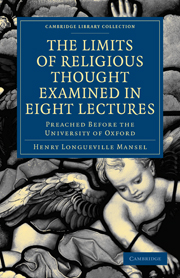 The Limits of Religious Thought Examined in Eight Lectures
The Limits of Religious Thought Examined in Eight Lectures Book contents
Summary
“FOR WHAT MAN KNOWETH THE THINGS OF A MAN, SAVE THE SPIRIT OF MAN WHICH IS IN HIM? EVEN SO THE THINGS OF GOD KNOWETH NO MAN, BUT THE SPIRIT OF GOD.”
The conclusion to be drawn from our previous inquiries is, that the doctrines of Revealed Religion, like all other objects of human thought, have a relation to the constitution of the thinker to whom they are addressed; within which relation their practical application and significance is confined. At the same time, this very relation indicates the existence of a higher form of the same truths, beyond the range of human intelligence, and therefore not capable of representation in any positive mode of thought. Religious ideas, in short, like all other objects of man's consciousness, are composed of two distinct elements,—a Matter, furnished from without, and a Form imposed from within by the laws of the mind itself. The latter element is common to all objects of thought as such: the former is the peculiar and distinguishing feature, by which the doctrines of Revelation are distinguished from other religious representations, derived from natural sources: or by which, in more remote comparison, religious ideas in general may be distinguished from those relating to other objects. Now it is indispensable, before we can rightly estimate the value of the various objections which are adduced against this or that representation of Christian doctrine, to ascertain which of these elements it is, against which the force of the objection really makes itself felt.
- Type
- Chapter
- Information
- The Limits of Religious Thought Examined in Eight LecturesPreached before the University of Oxford, in the Year M.DCCC.LVIII on the Foundation of the Late Rev. John Bampton, pp. 118 - 140Publisher: Cambridge University PressPrint publication year: 2009First published in: 1867
